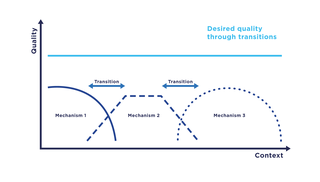Related Research Articles
Sociotechnical systems (STS) in organizational development is an approach to complex organizational work design that recognizes the interaction between people and technology in workplaces. The term also refers to the interaction between society's complex infrastructures and human behaviour. In this sense, society itself, and most of its substructures, are complex sociotechnical systems. The term sociotechnical systems was coined by Eric Trist, Ken Bamforth and Fred Emery, in the World War II era, based on their work with workers in English coal mines at the Tavistock Institute in London.

Self-organization, also called spontaneous order, is a process where some form of overall order arises from local interactions between parts of an initially disordered system. The process can be spontaneous when sufficient energy is available, not needing control by any external agent. It is often triggered by seemingly random fluctuations, amplified by positive feedback. The resulting organization is wholly decentralized, distributed over all the components of the system. As such, the organization is typically robust and able to survive or self-repair substantial perturbation. Chaos theory discusses self-organization in terms of islands of predictability in a sea of chaotic unpredictability.
Context awareness is a property of mobile devices that is defined complementarily to location awareness. Whereas location may determine how certain processes around a contributing device operate, context may be applied more flexibly with mobile users, especially with users of smart phones. Context awareness originated as a term from ubiquitous computing or as so-called pervasive computing which sought to deal with linking changes in the environment with computer systems, which are otherwise static. The term has also been applied to business theory in relation to contextual application design and business process management issues.
Bio-inspired computing, short for biologically inspired computing, is a field of study which seeks to solve computer science problems using models of biology. It relates to connectionism, social behavior, and emergence. Within computer science, bio-inspired computing relates to artificial intelligence and machine learning. Bio-inspired computing is a major subset of natural computation.
Autonomic computing (AC) refers to the self-managing characteristics of distributed computing resources, adapting to unpredictable changes while hiding intrinsic complexity to operators and users. Initiated by IBM in 2001, this initiative ultimately aimed to develop computer systems capable of self-management, to overcome the rapidly growing complexity of computing systems management, and to reduce the barrier that complexity poses to further growth.

A multi-agent system is a computerized system composed of multiple interacting intelligent agents. Multi-agent systems can solve problems that are difficult or impossible for an individual agent or a monolithic system to solve. Intelligence may include methodic, functional, procedural approaches, algorithmic search or reinforcement learning.

Julian Lombardi is an American inventor, author, educator, and computer scientist known for his work with socio-computational systems, scalable virtual world technologies, and in the design and deployment of deeply collaborative virtual learning environments.
Katia Sycara is a professor in the Robotics Institute, School of Computer Science at Carnegie Mellon University internationally known for her research in artificial intelligence, particularly in the fields of negotiation, autonomous agents and multi-agent systems. She directs the Advanced Agent-Robotics Technology Lab at Robotics Institute, Carnegie Mellon University. She also serves as academic advisor for PhD students at both Robotics Institute and Tepper School of Business.
The Workshop on Software Engineering for Adaptive and Self-Managing Systems (SEAMS) is an academic conference for exchanging research results and experiences in the areas of autonomic computing, self-managing, self-healing, self-optimizing, self-configuring, and self-adaptive systems theory. It was established in 2006 at the International Conference on Software Engineering (ICSE). It integrated workshops held mainly at ICSE and the Foundations of Software Engineering (FSE) conference since 2002, including the FSE 2002 and 2004 Workshops on Self-Healing (Self-Managed) Systems (WOSS), ICSE 2005 Workshop on Design and Evolution of Autonomic Application Software, and the ICSE 2002, 2003, 2004 and 2005 Workshops on Architecting Dependable Systems.
Autonomous logistics describes systems that provide unmanned, autonomous transfer of equipment, baggage, people, information or resources from point-to-point with minimal human intervention. Autonomous logistics is a new area being researched and currently there are few papers on the topic, with even fewer systems developed or deployed. With web enabled cloud software there are companies focused on developing and deploying such systems which will begin coming online in 2018.
Lateral computing is a lateral thinking approach to solving computing problems. Lateral thinking has been made popular by Edward de Bono. This thinking technique is applied to generate creative ideas and solve problems. Similarly, by applying lateral-computing techniques to a problem, it can become much easier to arrive at a computationally inexpensive, easy to implement, efficient, innovative or unconventional solution.

Jeffrey M. Bradshaw is a Senior Research Scientist at the Florida Institute for Human and Machine Cognition (IHMC), where he led the research group developing the KAoS policy and domain services framework for distributed systems management and coordination of human-agent-robot teamwork. He also co-leads the development of the Luna Agent Framework and the Sol Cyber Framework. Bradshaw chairs the Scientific Advisory Council for the Nissan Research Center Silicon Valley (NRC-SV), which has the development of autonomous vehicles as a major focus. He and his wife, Kathleen, began a two-year leave of absence from IHMC beginning July 2016 to serve a church mission in the Democratic Republic of Congo, Kinshasa Mission of The Church of Jesus Christ of Latter-day Saints, and began another six months to serve in the new Kinshasa Democratic Republic of the Congo Temple.
The LIDA cognitive architecture is an integrated artificial cognitive system that attempts to model a broad spectrum of cognition in biological systems, from low-level perception/action to high-level reasoning. Developed primarily by Stan Franklin and colleagues at the University of Memphis, the LIDA architecture is empirically grounded in cognitive science and cognitive neuroscience. In addition to providing hypotheses to guide further research, the architecture can support control structures for software agents and robots. Providing plausible explanations for many cognitive processes, the LIDA conceptual model is also intended as a tool with which to think about how minds work.
In artificial intelligence research, the situated approach builds agents that are designed to behave effectively successfully in their environment. This requires designing AI "from the bottom-up" by focussing on the basic perceptual and motor skills required to survive. The situated approach gives a much lower priority to abstract reasoning or problem-solving skills.
Princeton Application Repository for Shared-Memory Computers (PARSEC) is a benchmark suite composed of multithreaded emerging workloads that is used to evaluate and develop next-generation chip-multiprocessors. It was collaboratively created by Intel and Princeton University to drive research efforts on future computer systems. Since its inception the benchmark suite has become a community project that is continued to be improved by a broad range of research institutions. PARSEC is freely available and is used for both academic and non-academic research.
In cloud computing, elasticity is defined as "the degree to which a system is able to adapt to workload changes by provisioning and de-provisioning resources in an autonomic manner, such that at each point in time the available resources match the current demand as closely as possible". Elasticity is a defining characteristic that differentiates cloud computing from previously proposed computing paradigms, such as grid computing. The dynamic adaptation of capacity, e.g., by altering the use of computing resources, to meet a varying workload is called "elastic computing".
Microservices are a software development technique —a variant of the service-oriented architecture (SOA) structural style— that arranges an application as a collection of loosely coupled services. In a microservices architecture, services are fine-grained and the protocols are lightweight.

Hausi A. Müller is a Canadian computer scientist and software engineer. He is a professor of computer science at the University of Victoria, British Columbia, Canada and a Fellow of the Canadian Academy of Engineering.
Martin Wirsing is a German computer scientist, and Professor at the Ludwig-Maximilians-Universität München, Germany.

Transition refers to a computer science paradigm in the context of communication systems which describes the change of communication mechanisms, i.e., functions of a communication system, in particular, service and protocol components. In a transition, communication mechanisms within a system are replaced by functionally comparable mechanisms with the aim to ensure the highest possible quality, e.g., as captured by the quality of service.
References
- Müller-Schloer, Christian; v.d. Malsburg, Christoph and Würtz, Rolf P. Organic Computing. Aktuelles Schlagwort in Informatik Spektrum (2004) pp. 332–336.
- Müller-Schloer, Christian. Organic Computing – On the Feasibility of Controlled Emergence. CODES + ISSS 2004 Proceedings (2004) pp 2–5, ACM Press, ISBN 1-58113-937-3.
- Rochner, Fabian and Müller-Schloer, Christian. Emergence in Technical Systems. it Special Issue on Organic Computing (2005) pp. 188–200, Oldenbourg Verlag, Jahrgang 47, ISSN 1611-2776.
- Schmeck, Hartmut. Organic Computing – A New Vision for Distributed Embedded Systems. Proceedings of the Eighth IEEE International Symposium on Object-Oriented Real-Time Distributed Computing (ISORC’05) (2005) pp. 201–203, IEEE, IEEE Computer Society 2005.
- Würtz, Rolf P. (Editor): Organic Computing (Understanding Complex Systems). Springer, 2008. ISBN 978-3642096426.